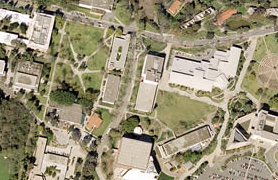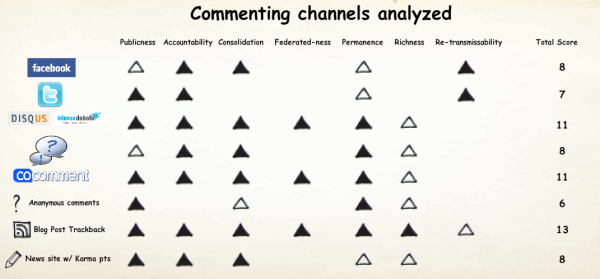 If you were tasked with re-architecting the typical high school experience with the end goal of “better equipping students for whatever they do next,” what changes would you make? Don’t confine your ideas to simple curriculum changes either, go nuts. Change anything about the full experience. Some aspects to consider:
If you were tasked with re-architecting the typical high school experience with the end goal of “better equipping students for whatever they do next,” what changes would you make? Don’t confine your ideas to simple curriculum changes either, go nuts. Change anything about the full experience. Some aspects to consider:
- how are classes delivered?
- what is the best use of classroom time and what interaction can be conducted electronically?
- how are parents involved?
- how are grades determined?
- how are grades reported?
- is there another system besides standardized testing that will yield objective results?
- is striving for objective results even the real goal?
- how early is too early to fork the paths of college-prep hopefuls from others?
- what skills are timeless and is there a better approach than the current one for developing these?
- what’s the new interaction model look like in the classroom?
- if the agile manifesto were written from the perspective of teachers today, how would it read?
- what aspects of how classes are rendered is completely legacy and can be thrown out
- are there any fundamental sea changes occurring with skill development like shift from knowledge-retention as a goal to development of knowledge acquisition strategies?
- how do you amplify “street smarts,” social skills & intangible benefits?
- what can be entirely eliminated from the existing system?
Every time I hear the phrase “education reform” I cringe. Not because I don’t believe it needs reforming, but because the people throwing the phrase around are thinking in terms of “How can we boost standardized test scores? How can we graduate more students? What counseling programs can be introduced to reduce dropouts?” In other words, they’re thinking purely in terms of optimizations to the existing flawed system. The phrase “lipstick on a pig” comes to mind. These people unfortunately suffer from the same “curse of knowledge” that will guarantee their thinking remains constrained to the current paradigm.
Try this Innovation Games exercise: Try to imagine forward ten years. The kids that are currently in high school now will be a few years into the workforce (and possibly more if they skipped the college step). Hold an image of prosperity. Picture a scene of advanced living standards, a world successfully meeting challenges from all sides with our environment, urban development, natural resources, international relations, medical challenges, etc. Picture the younger people who are either responsible for these advancements or who are delivering the labor to render these developments. NOW…
Project yourself back ten years from this future point of prosperity and ask “What must the high school environment for these young adults had to have looked like for them to develop the qualities they possess today?” Note: this is a waaay different question than the typical “what should we change today about schools?”
I haven’t thought through all these suggestions entirely but here are some raw ideas that I’ve been thinking about:
Curriculum substitutions
Allow students to nix their current electives and choose from the following:
- basic accounting & finance: reconcile statements, concepts of interest, budgeting, investing
- speed reading
- typing
- practical web knowledge: effective search techniques, web fundamentals, intro web apps
- GTD methodology
- collaborative web applications 201
- negotiating
- persuasive writing
- public speaking
- sketching
- team collaboration
- scientific method
- critical reading
- logical fallacies
- entrepreneurship
- personal branding
- nutrition, health & wellness
- money management
- time management
- stress management
- basic auto maintenance
- minor home repairs: clothing fixes, appliance maintenance
- incentives & economics
- career safari
While these are typically thought of as college subjects I believe they’re core enough to merit pulling them down into the latter half of high school. The fact that things like money management, critical reasoning skills, basic auto maintenance and time management were never taught has always seemed like a major omission. And how obvious is it to have a course that exposes students to the breadth of careers available and plant early seeds which the student can investigate? While my high school experience was 90% quality, we had courses like Biology, Calculus and European history which I would have gladly traded in a heartbeat for any of the above.
Interaction model changes
To me it’s clear the interaction model needs to move away from the primarily unidirectional “hub and spoke” teacher-broadcasting-to-students approach. It needs to move towards a clustered student-to-student group mesh interaction with the teacher as facilitator. The immediate response is likely “wouldn’t this just be pure chaos with blind leading the blind?” The key is to think of this mesh spanning vertically across grades. Look to the interaction model of a martial arts dojo where experienced students must teach smaller groups of novice students in order to advance to their next belt. When you must learn something to the point at which you can teach it to others, it necessitates an entirely different level of understanding (not to mention it amplifies the power of your teaching force and the new “teachers” are much closer in demographic profile to their students and therefore better able to relate).
Course goal changes
The concept of courses as we know them today seems at best geared towards “imparting knowledge” and at worst “teaching to the test.” Perhaps the goal of school needs to be rethought more in terms of one’s “essence discovery,” cultivating raw talents, inspiring students to seek to develop these and most importantly, getting to a point of being excited to pursue whatever is next? We need to think of educating kids more like developing an athlete. I had this discussion with a good friend over lunch the other day: it seems like schooling for us mostly consisted of loading our mental computers up with software. The game now has changed and it’s more about developing our CPU/RAM capacity, installing a better OS and learning strategies for finding the software we need at runtime.
Grading model changes
To support the above goal, the concept of grades needs to be reassessed entirely. Given how the world works clinging to standardized testing is like if eBay were to discard its peer rating system in favor of a 100pt multiple-choice test administered to each buyer to determine buyer ratings. Sure, it’s a more standardized approach… but that’s all it is. It sacrifices meaningfulness for the preservation of “standards.” I don’t have a concrete proposal for what this new system should be but I know when something’s broken and standardized testing (especially the AIM’s test) is horrifically broken. We need to consider moving to a market-driven peer-review type grade system. Investigate marketplaces like Elance and “asymmetric follow” systems like Twitter to get ideas here.
Changes to Parent involvement
When I was in high school we had a parent teacher conference once a semester. One night. Likely the only interaction our folks would have with our teachers (unless we really f’d up in class that semester). With all the low-friction collaborative tech that’s available these days there has to be a way to channel more meaningful input to the parents and get more pro-active involvement out of them. Invested parents can compensate for a crappy teacher (I know this first hand) while it’s nearly impossible for the best teachers in the world to overcome a crappy parenting situation. And involved parents are better parents. Private microblogging platforms are what I’m envisioning here.
Getting Real
Cordon off at least 1/4 of the time for teaching skills in a Startup Weekend-esque way (ie. not explicitly but rather via pursuit of finishing a real project). Pick from non-profit endeavors or other public works projects and deliver some aspect as part of your class. Fieldtrips weren’t always about ditching the tedium of the classroom and goofing off, they were reminders of how what you were learning was applicable to real life. There’s a lot of room to move what’s currently being taught in classrooms into field exercises. The result is students that are more engaged and learning that gets more deeply encoded and anchored with real experience so it can be recalled later.
Anyways, this post is getting too long. I have a bunch of other ideas, but what do you think? What changes will have needed to have occurred for the workforce ten years from now to be flourishing?
 The title is a reference to the final scene of one of the radest 80’s movies ever: “Back to the Future.” I remember walking out of that theater as a kid hopped up on red vines, Huey Lewis, the prospect of time travel, and all the possibility that a flying delorean represented. It seemed like anything was possible.
The title is a reference to the final scene of one of the radest 80’s movies ever: “Back to the Future.” I remember walking out of that theater as a kid hopped up on red vines, Huey Lewis, the prospect of time travel, and all the possibility that a flying delorean represented. It seemed like anything was possible.  I don’t have the original source on this anecdote but supposedly at a California college (Cal Poly?) they were redesigning the campus and trying to figure out where to build the new sidewalks. It was a complex arrangement of buildings and there were a bunch of conflicting opinions about where the sidewalks belonged. Someone had the ingenious idea that rather than speculating, they should instead run an experiment and let the market speak. So they planted grass the first year and waited. At the end of the year they took an aerial photo and the tread-worn ground became the blueprint for the optimal sidewalk routes as chosen perfectly and implicitly by the student body.
I don’t have the original source on this anecdote but supposedly at a California college (Cal Poly?) they were redesigning the campus and trying to figure out where to build the new sidewalks. It was a complex arrangement of buildings and there were a bunch of conflicting opinions about where the sidewalks belonged. Someone had the ingenious idea that rather than speculating, they should instead run an experiment and let the market speak. So they planted grass the first year and waited. At the end of the year they took an aerial photo and the tread-worn ground became the blueprint for the optimal sidewalk routes as chosen perfectly and implicitly by the student body. 
 Very simple: make it possible to loan a digital book to a friend. Not authorize the same book simultaneously across multiple computers on the same account, but actually de-auth it from one and give it to someone else.
Very simple: make it possible to loan a digital book to a friend. Not authorize the same book simultaneously across multiple computers on the same account, but actually de-auth it from one and give it to someone else. Check out the full list of
Check out the full list of 
 If you were tasked with re-architecting the typical high school experience with the end goal of “better equipping students for whatever they do next,” what changes would you make? Don’t confine your ideas to simple curriculum changes either, go nuts. Change anything about the full experience. Some aspects to consider:
If you were tasked with re-architecting the typical high school experience with the end goal of “better equipping students for whatever they do next,” what changes would you make? Don’t confine your ideas to simple curriculum changes either, go nuts. Change anything about the full experience. Some aspects to consider:  It can’t be assumed it will reach its intended recipient.
It can’t be assumed it will reach its intended recipient. 





